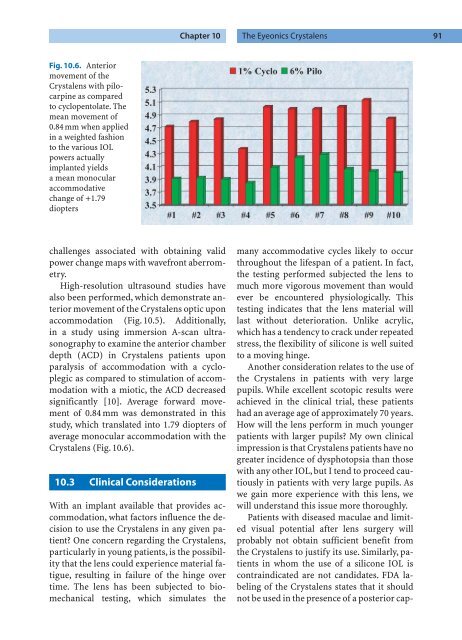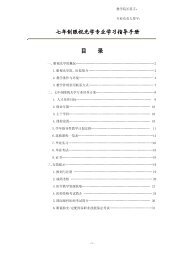Refractive Lens Surgery
Refractive Lens Surgery
Refractive Lens Surgery
Create successful ePaper yourself
Turn your PDF publications into a flip-book with our unique Google optimized e-Paper software.
Fig. 10.6. Anterior<br />
movement of the<br />
Crystalens with pilocarpine<br />
as compared<br />
to cyclopentolate. The<br />
mean movement of<br />
0.84 mm when applied<br />
in a weighted fashion<br />
to the various IOL<br />
powers actually<br />
implanted yields<br />
a mean monocular<br />
accommodative<br />
change of +1.79<br />
diopters<br />
challenges associated with obtaining valid<br />
power change maps with wavefront aberrometry.<br />
High-resolution ultrasound studies have<br />
also been performed, which demonstrate anterior<br />
movement of the Crystalens optic upon<br />
accommodation (Fig. 10.5). Additionally,<br />
in a study using immersion A-scan ultrasonography<br />
to examine the anterior chamber<br />
depth (ACD) in Crystalens patients upon<br />
paralysis of accommodation with a cycloplegic<br />
as compared to stimulation of accommodation<br />
with a miotic, the ACD decreased<br />
significantly [10]. Average forward movement<br />
of 0.84 mm was demonstrated in this<br />
study, which translated into 1.79 diopters of<br />
average monocular accommodation with the<br />
Crystalens (Fig. 10.6).<br />
10.3 Clinical Considerations<br />
With an implant available that provides accommodation,<br />
what factors influence the decision<br />
to use the Crystalens in any given patient?<br />
One concern regarding the Crystalens,<br />
particularly in young patients, is the possibility<br />
that the lens could experience material fatigue,<br />
resulting in failure of the hinge over<br />
time. The lens has been subjected to biomechanical<br />
testing, which simulates the<br />
Chapter 10 The Eyeonics Crystalens 91<br />
many accommodative cycles likely to occur<br />
throughout the lifespan of a patient. In fact,<br />
the testing performed subjected the lens to<br />
much more vigorous movement than would<br />
ever be encountered physiologically. This<br />
testing indicates that the lens material will<br />
last without deterioration. Unlike acrylic,<br />
which has a tendency to crack under repeated<br />
stress, the flexibility of silicone is well suited<br />
to a moving hinge.<br />
Another consideration relates to the use of<br />
the Crystalens in patients with very large<br />
pupils. While excellent scotopic results were<br />
achieved in the clinical trial, these patients<br />
had an average age of approximately 70 years.<br />
How will the lens perform in much younger<br />
patients with larger pupils? My own clinical<br />
impression is that Crystalens patients have no<br />
greater incidence of dysphotopsia than those<br />
with any other IOL, but I tend to proceed cautiously<br />
in patients with very large pupils. As<br />
we gain more experience with this lens, we<br />
will understand this issue more thoroughly.<br />
Patients with diseased maculae and limited<br />
visual potential after lens surgery will<br />
probably not obtain sufficient benefit from<br />
the Crystalens to justify its use. Similarly, patients<br />
in whom the use of a silicone IOL is<br />
contraindicated are not candidates. FDA labeling<br />
of the Crystalens states that it should<br />
not be used in the presence of a posterior cap-



